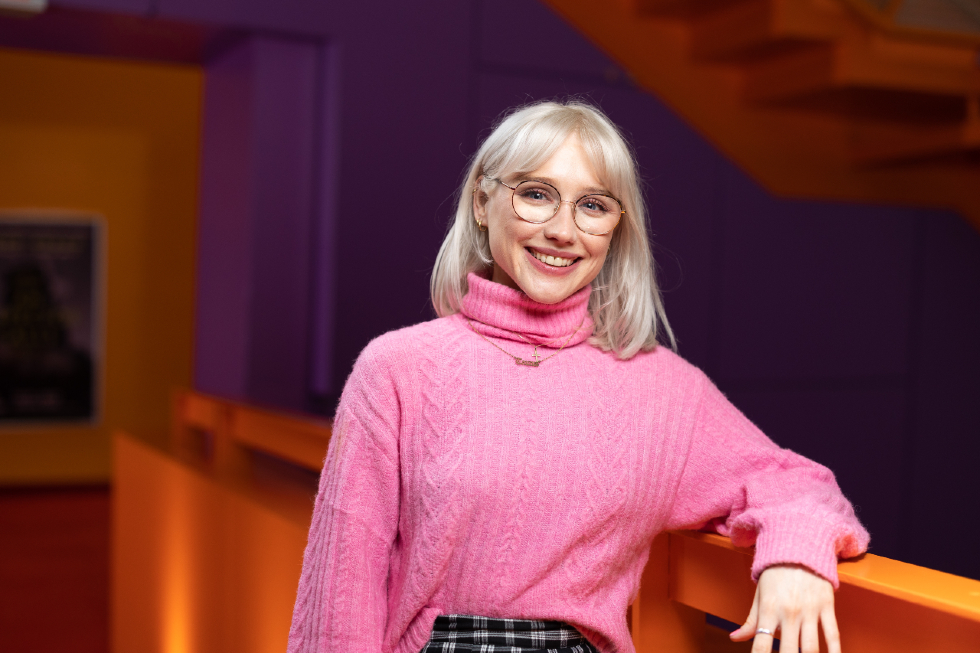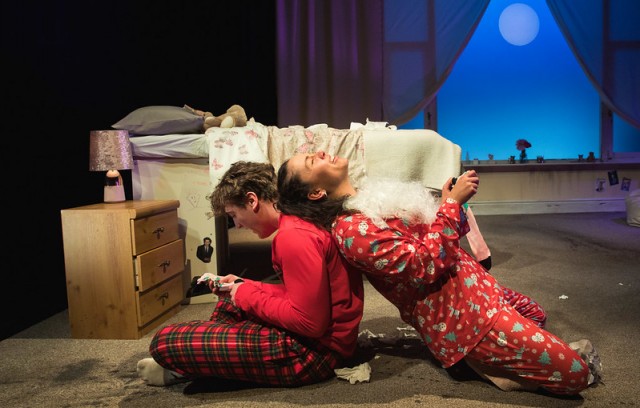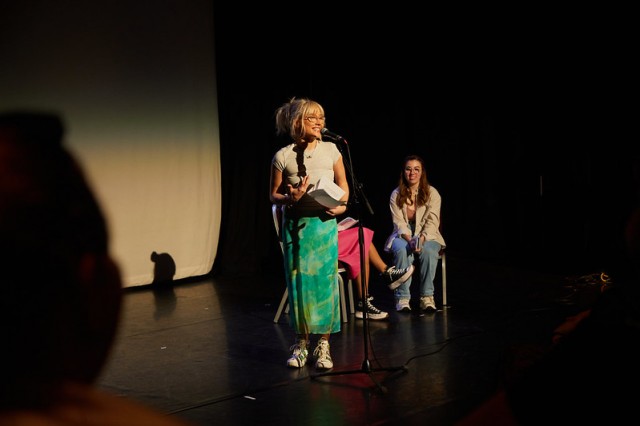The Big Interview: Alice Christina-Corrigan

“I can’t wait to see what we can do.” Mike Pinnington spoke with actor, writer and creative access director, Alice Christina-Corrigan, about the Lowry’s Developed With programme, the strides being made for representation in theatre, and the challenges still to be overcome…
“I think it’s really hard to get bums on seats; it’s been a real passion of mine to look at how we can make theatre appealing to a younger demographic. I don’t necessarily mean kids. But, from teenagers all the way to 30; the generation that is kind of disconnecting with theatre.”
I’m speaking with actor, writer and creative access director – more of which later – Alice Christina-Corrigan, who has just brought her play, FADE, about “sibling allyship” to the stage (at Salford’s Lowry and Leeds Playhouse, respectively). Inspired by (though not about) her relationship with her brother, FADE follows twins Cassie and Rubin whose mother has suddenly died, and explores universal themes against a backdrop of shifting timelines. At the Lowry where it debuted, its second night was a sell out. “To have had two really lovely nights with a really beautiful group of audience members… It was a really big thing for me, because I know how difficult that is.”
Acknowledging the difficulties in getting new writing out there, Christina-Corrigan tells me: “it’s always a bit mad, seeing something that’s existed in your head for years, on the stage. It was quite overwhelming, in a really beautiful way.” When I ask about the challenges, she begins: “I feel like there are so many! But a massive reason for that is, because of the situation we find ourselves in, with funding and the government and how theatres are having to work at the minute, it’s far safer to put on shows that are recognised classics.

“I can understand why that is the way it is. But,” she continues, “I think that has led to a massive disconnect with people who want to be working in the arts, and making new work, and telling [new] stories; it’s becoming increasingly hard to find the space to do [it in]. We want to get bums on seats but, actually, well, the bums on seats we’re getting tend to be a demographic that I know doesn’t reflect me. I know it doesn’t reflect a lot of my friends. We’re not going to go and watch something that we don’t feel connected to.”
How to kick back against the risk averse status quo, and make new work that connects with more diverse prospective audiences? Describing herself as a “solutions-based person” Christina-Corrigan says that: “As a writer, I’m wanting to challenge that by creating a show that I think has longevity, and a future life – because of the themes, and the way in which it’s told.”
Another crucial factor in connecting with audiences who might otherwise be turned off by productions “that do not reflect the world that we know, and sometimes take our working-class, disabled stories and give them to a class that doesn’t reflect us” is doing the leg work in terms of engagement. “What’s beautiful about the Lowry and Leeds Playhouse, is that it’s an organisation that has a mixture of touring and in-house productions. Both the Lowry and Leeds Playhouse are really supportive of local artists and building with the community. Community engagement is really, really important.”
Anybody who has ever worked with audiences, however, will know that such engagement can be easier said than done. “I’m an advocate for trying to have longer stints of time to build up a relationship with communities – whether that be discounted tickets, or a workshop with the university – finding a way in which we can creatively engage with the community instead of seeing that as a separate thing.”
A case in point was the production’s work with Manchester Sight Loss Council, who sat in on rehearsals. They, says Christina-Corrigan, gave feedback and, notably, “the demographic of that group was very broad. A lot of them were saying that they’ve never had the opportunity to do stuff like this; it built up an engagement for them to want to come to see the show.”
Who gets to tell stories, and who then is the audience for those stories, is critical. “They [theatres] are just not spaces that people always feel seen, or heard in, or have even thought about coming into. It’s a shift that we need to make. But that shift includes risks.” Unsurprisingly, there is, in some quarters, a reluctance to even consider making the required shifts. Has she experienced push back in this regard? And what gives her the energy and impetus to inspire change?
“I was born with two eye conditions, I’m visually impaired. I don’t necessarily quote-unquote ‘look disabled,’ which gives you a whole array of mental hurdles to kind of get over. But it also meant that I had the ability to kind of just coast along and mask, and didn’t really even engage. I didn’t see people like me with disabilities working in the arts. I didn’t even realise it was a thing.”
She did, however, always understand the potential to affect change. “Even before I really found creative access, it was always about politically saying something, or working with the community and collaborating. I did a lot of youth theatre, I was in the YEP [Young Everyman Playhouse] in Liverpool; everything we made there, there was always an agenda behind it, a message. So that’s always been in me.”
By the time she’d studied for her Masters, she’d “got to a point where I had the space and capacity to write something and ask a question. I think that led me to looking at it from a more creative perspective rather than access as this 2D framework that we put on at the end of a production. It can aid storytelling, the same way movement can, the same way sound and lighting does, as this multi-faceted tool that we have, that is also the integration of access, and creative access.”
She’s wary, however, of cynicism: “There were spaces that we were being put in that weren’t, um, actually endorsing access, but rather seeing it as a tick box.” This led her to thinking in more nuanced ways about how she wanted to address and introduce ways of championing greater diversity. “Instead of it [being] industry-facing or public-facing, it was about how I can create a whole production company that is between 80% to 90% disabled, I think 95% working class, and predominantly a queer-based environment.
“We had a creative access R+D at [Sheffield's] Theatre Deli last November. That wasn’t us in an echo chamber, talking about how hard it is for us and sitting in the negativity – which is valid – but that can be quite heavy sometimes. This was just creative space. We were playing with lighting and projector movements. We had actors looking at how they could take the vibrations of the sounds and integrate their breaths, so that we could, in non-verbal scenes, have integrated audio description.” Out of which, she says, grew “emerging learning with established artists, who all took pieces of what we created into their own practise, which is, for me, the biggest. We’re always adding to the talk. The moment we stop learning, that’s bad.”
A potential positive outcome is to make an invitation and lay the groundwork for others to build on. “One of our sound designers, Sophia, said: ‘this is now my baseline for how I expect to be treated in the industry.’ For me, that’s exactly why I’m doing what I do. Not only in what you’re seeing on stage, but also behind the scenes, because disabled people deserve to work in the arts. I think that’s what’s been really validating; there clearly is a want and need and desire for these conversations, and for this movement to be happening.”
For recent production, FADE, Christina-Corrigan worked over a months-long period at the Lowry on their Developed With programme, which supports artists of all stripes in the production of new work. It is, she unequivocally tells me, “one of the best arts development schemes that I have ever been on, and the standard for how we should be developing artists. I’ve been on many different artist development schemes over the years; some are great, some are not.”

At the Lowry, she continues, “I was pushed to look at how I can step up. Look at how I can create an Arts Council bid [for example]. Look at how I can pitch all of what I want to do and then have a team around me going. ‘Okay, cool. Let’s do it. Let’s make it.’ I now have the vocabulary and experience and confidence and support in myself to be able to ask these questions and know what the answer should be.”
Given so positive an experience, is the relationship going to be maintained, now FADE’s first run has concluded, I ask. “We’re already talking about future projects, and you can see that continued relationship through this scheme. It’s led to what FADE is today, through so many conversations that, 18 months ago, I could never have thought would be possible.”
The play, though, isn’t in the past-tense, and Christina-Corrigan would love to see it developed, become more muscular in its production with, among other things, sound playing a more prominent role. “This was our first rodeo with it. I’m excited to look at integrating a lot more movement and sound; I think there’s much more to be explored.”
But she’s also begun work on her next production. “I’m in the early days of developing my next play, 90+5, and it’s about women in football, about what football means to us; it means so much more than just those 90 minutes on the pitch. We’ve got some great support on it. Fingers crossed that will be beginning this summer.”
On-stage and off, Christina-Corrigan knows there’s still work to be done. “I’m pushing myself, having these industry chats with people. I want to be talking to people higher up, because we can’t be mad at young emergent artists who can’t afford to have creative captioning to make work more accessible. They’re not the problem. Which is a very uncomfortable position to find yourself in. But for me, again, I’m a solution-based person. I think the answer is: we can still make our art and have it.
“It’s not ticking a box. It’s not having one accessible show in your season about the negative stigmas attached to disability. Those stories are needed and there’s a space for them, but like, for me, if we want to actually make this cultural shift, it comes with looking at how we can integrate creative access in a way that reflects every story that we’re telling.”
You wouldn’t bet against her continuing to make a mark, both creatively and access-wise. The ongoing support she’s received from the Lowry and others has inspired, she says, “a real element of belief. I know that for many artists, that could be really difficult to come about.” As “one chapter has ended” – at least for now – with FADE, she says that “another one’s about to begin, and that’s really, really special, and not wasted on me. I feel mad grateful; I can’t wait to see what we can do, because I think it’s a beautiful thing, us working together, and building further. There’s a legacy being built, and I just wanted to be part of it.”
Mike Pinnington
Images, from top, courtesy Phil Tragen; Andrew AB Photography; Shawn J Stephen





